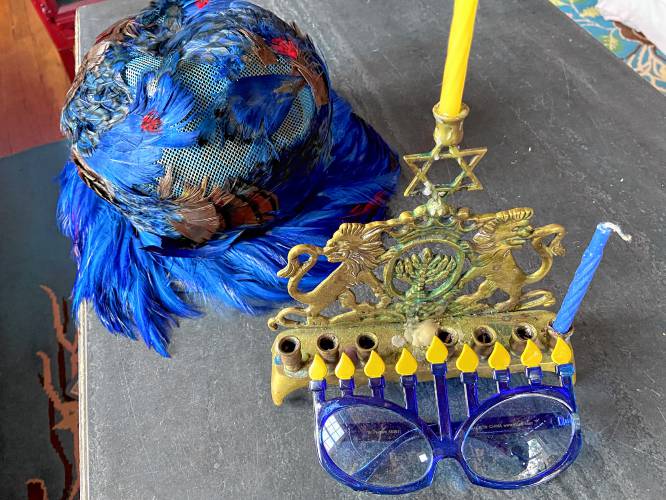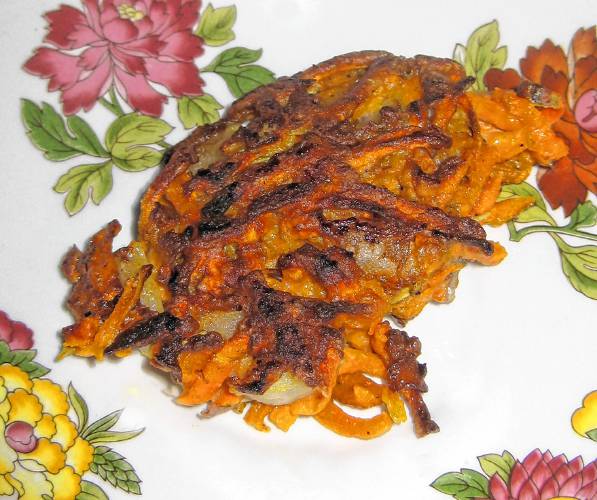A new twist on the latke
|
Published: 12-05-2023 5:23 PM
Modified: 12-05-2023 7:16 PM |
Hanukkah begins tomorrow night, Dec. 7, at sunset. Sunset arrives earlier and earlier at this time of year as we approach the longest night of the year.
To bolster our spirits in the darkness, holidays like Hanukkah and Christmas celebrate the gift of light.
As many readers probably know, Hanukkah recalls a time during the second century B.C.E. Judea had been under the thumb of the Greeks since its conquest by Alexander the Great.
Alexander and his immediate successors were tolerant of the different ethnic and religious groups in their midst. Antiochus IV, more than a century after Alexander, was a different story.
A rabid champion of Hellenistic culture and religion, he replaced the priest in the Temple in Jerusalem with one of his own priests and prohibited the practice of Judaism on pain of death. He dedicated the temple to Zeus and slaughtered many Israelites.
The Jews rose up under the leadership of Judah Maccabee (also referred to as Judas Maccabeus). After battling for three years, they finally managed to rout the Greeks and live independently … at least until the Romans came along and conquered the area about 100 years later.
They rebuilt the temple and its altar. To rededicate the temple, they lit an oil-powered menorah (candelabrum) that was supposed to burn continuously. According to legend, they had only enough oil to keep the flame burning for a single day. Miraculously, it lasted for eight days and nights, until more oil could be brought to the temple.
Hanukkah thus celebrates several things: a Jewish victory (not a common thing in world history), the strength of religious faith, and above all, the power of light.
Article continues after...
Yesterday's Most Read Articles
I love celebrating light in all its forms at this time of year. My Christmas lights were hung the weekend after Thanksgiving. I usually get out my dreidel lights (the dreidel is a top spun traditionally during Hanukkah) as well, although I’m still looking for them this year.
My nephew recently installed LED lights in strings around the walls of my sitting area; they look like a theater marquee. The lights can be any color I choose. They are currently blue (a traditional Hanukkah color here in the United States) as I prepare for tomorrow evening. And of course I have retrieved my menorah from its drawer so that I can begin to light the candles tomorrow evening.
As a food person, I always want to celebrate Hanukkah or any other holiday in the kitchen. To commemorate the miracle of the oil, fried food is traditional at this time of year. Many people enjoy sufganiyot, a form of jelly doughnut.
I like sweets as much as the next person, but my family always preferred savory latkes (potato pancakes), so I make them at least once during the eight-day holiday. (Making them every day would be excessive and might even cause the cook to tire of them.)
I love latkes plain with lots of potato and onion. Readers may recall variations I have made over the years and written about here, including the Holy Guaca-Latke, a latke with guacamole, and the Wafflatke, a latke cooked in a waffle iron.
This year I’m going to revive a recipe I first made for my family 14 years ago, the Yam-e-ke. This is a latke made with sweet potatoes. It is a little less crispy than the traditional potato latke, but it abounds with color and flavor.
I know that sweet potatoes aren’t really yams, but the name appeals to me.
Like most of my latkes, these are messy but tasty. I like adding rosemary to some of them, particularly when serving them with poultry. My nephew Michael, who calls rosemary leaves “those sticks,” prefers them plain. I’m making the rosemary optional in his honor.
Ingredients:
2 good-sized sweet potatoes
1 large onion, more or less finely chopped
2 eggs, beaten
6 tablespoons flour or matzo meal (plus a little more if you need it)
1 teaspoon kosher or sea salt
Several grinds of a pepper mill
1 teaspoon dried (or 2 teaspoons fresh) rosemary (optional)
Extra-virgin olive oil as needed for frying
Instructions:
Wash the sweet potatoes well and peel them if you want to. (The skins are nutritious so you don’t have to.) Grate them using the grater attachment of a food processor or a box grater. Do not use the main blade of the food processor as it will make the pieces of sweet potato small and wet.
Wrap the shreds of sweet potato in a clean dishtowel. Carry it to the sink and wring out as much liquid as you can. Leave the wrapped shreds in the sink to drain while you prepare the rest of the ingredients (and maybe have a cocktail or two).
In a medium bowl, combine the sweet potato pieces, the onion, the eggs, the flour or matzo meal, the salt, the pepper and the rosemary (if you’re using it).
In a large frying pan, heat a few tablespoons of oil until the oil begins to shimmer.
Scoop some of the sweet potato mixture out of the bowl with a soup spoon, and flatten it with your hand. Pop the flattened pancake into the hot oil. The oil should hiss and bubble a bit. If it doesn’t, wait before you place more pancakes in the pan.
It’s just fine if your yam-e-kes are a little ragged around the edges. If they don’t hold together and are hard to turn, however, you may want to add a little more flour to your batter.
Fry the pancakes a few at a time, turning each when the first side turns a golden brown. Drain the cooked latkes on paper towels; then pop them into a 250-degree oven to stay warm until their cousins finish cooking.
Serves six to eight as a side dish.
Tinky Weisblat is an award-winning cookbook author and singer known as the Diva of Deliciousness. Visit her website, TinkyCooks.com.



 Speaking of Nature: Indulging in eye candy: Finally, after such a long wait, it’s beginning to look like spring is here
Speaking of Nature: Indulging in eye candy: Finally, after such a long wait, it’s beginning to look like spring is here Celebrating ‘Seasonings’: New book by veteran preacher and poet, Allen ‘Mick’ Comstock
Celebrating ‘Seasonings’: New book by veteran preacher and poet, Allen ‘Mick’ Comstock Faith Matters: How to still the muddy waters of overthinking: Clarity, peace and God can be found in the quiet spaces
Faith Matters: How to still the muddy waters of overthinking: Clarity, peace and God can be found in the quiet spaces A time for every purpose under heaven: Free sing-a-long Pete Seeger Fest returns to Ashfield, April 6
A time for every purpose under heaven: Free sing-a-long Pete Seeger Fest returns to Ashfield, April 6
